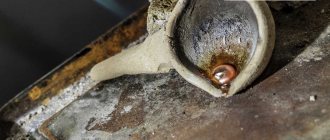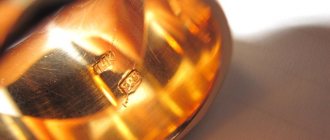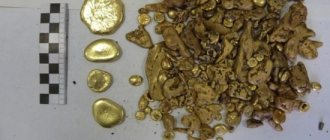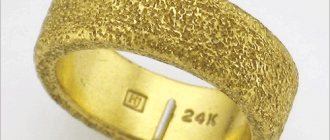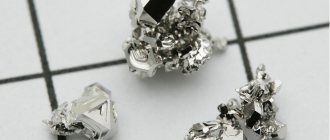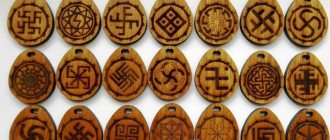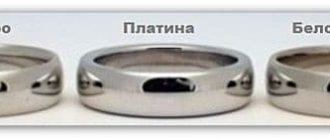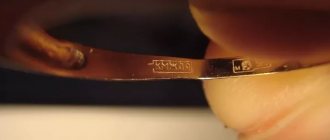Precious metals been counterfeited .
They spoiled the sample by adding an excessive amount of base metals to the gold alloy, creating that looked similar in appearance to noble aurum, but did not contain a single gram of gold.
Demand creates supply, and the demand for cheap imitation gold has always been great.
During the 19th and especially the 20th centuries, the “imitation industry” developed particularly rapidly.
Another example: there is also the so-called “white gold” - a gold alloy that is valued as highly as classic yellow, and in some cases even higher. But upon visual inspection, it is difficult white gold from silver or platinum .
Precious metal analyzers are designed to accurately determine from what metal or metal alloy a piece of jewelry is created, an ingot is cast, or a coin is minted.
The essence and purpose of the analyzer
A precious metal analyzer is a device designed to determine what metal a particular item is made of - a ring, coin, bar, etc.
The device determines the exact quantitative composition of various chemical elements in the product and shows the percentage of noble to base metals.
Simply put, a modern precious metals analyzer determines how much pure metal a given product contains:
- gold;
- silver;
- palladium;
- rhodium;
- other noble metals, and how many impurities (nickel, copper, zinc, chromium, etc.).
The sample size of the product
is determined by the ratio of gold or silver to the amount of impurities .
So, for example, the most common 585 gold standard in Russia contains 58.5% pure metal, and the rest is made up of impurities introduced to give the alloy greater strength, since pure gold is too soft.
Some devices immediately display the sample, others display a numerical code or the percentage of various metals on the screen, and the sample is determined by the appraiser using a special table.
Of course, if there are no precious metals in the product, the device will also show this.
How can you test gold at home?
We have collected several of the safest methods that, if all rules are followed, will not cause harm to either the product itself or the human body due to potential toxicity.
Iodine
Perhaps the most harmless and simple method, consisting of elementary rules:
- Take a regular pharmaceutical iodine solution and dip a cotton swab in it.
- Gently apply a small dab onto a flat surface.
- If the spot begins to lighten or turn white, there is more copper or brass in the product than gold. Remains dark brown – 585 standard is real.
You can clean gold from iodine with an aqueous solution of hyposulfate (ampoules are sold in pharmacies), or a mixture of hydrogen peroxide and ordinary laundry soap. The only caveat is that soaking can take up to 30 minutes, depending on the size of the contamination.
Ammonia
The method is similar to iodine, with the difference that you will have to use a cotton swab soaked in ammonia as an eraser - rub the jewelry with it for at least 15 seconds, and then look at the mark. If the snow-white cotton wool takes on a bluish-dark tint, then the purchased item is fake. When the color does not change and there are no unpleasant traces, copper is within normal limits.
lapis pencil
It can also be found in most pharmacies at a price that is ridiculous by drug standards. It’s even easier to use than with liquids - open it, draw a small line and carefully observe the result. There should be no traces left on the gold.
Vinegar
This method is not recommended for use at home, because the result requires vinegar essence heated over an open fire with a concentration of 80% or higher. Only then will the excess copper in the alloy color the liquid a pale blue hue. Regular table vinegar is useless - 6-9% is not enough to react with metal.
Operating principles of the device
From a design point of view, a precious metals analyzer is a highly specialized metal detector, similar to those used in other areas, for example, in rolled metal.
Only it is certified and tailored for the detection and recognition not of iron and carbon in a steel alloy, and not of copper and tin in a bronze alloy, but of precious metals : gold, silver, platinum in combination with various possible additives.
Only non-destructive testing can be used to check the quality of jewelry. This places restrictions on the physicochemical methods that can be used for research.
This is quite logical - you can’t spoil the product by separating fragments from it for chemical tests.
At the moment, two operating principles are used to create precious metal analyzers: X-ray fluorescence and electrochemical.
X-ray fluorescence
This method is based on exposing an object to low-power X-ray radiation using an artificial or natural source.
Early devices used natural materials - plutonium-238, iron-55, etc. Nowadays artificial ones are used more often.
The radiation power is so low that it cannot harm a person even with prolonged use of the device.
A stream of X-ray radiation “hits” an object, causing it to respond in the X-ray spectrum invisible to the human eye. The induced learning response, which is a flow of electrons, is detected by a highly sensitive sensor. This is fluorescence.
Each chemical element produces its own characteristic “glow” in the corresponding spectrum. The higher the content of a substance, the more powerful it will fluoresce.
A special program analyzes the total spectrum of radiation and determines the percentage of different metals with a high degree of accuracy - up to 0.1%. Each metal requires an individual program .
Another name for this device is an energy-dispersive detector, or spectrometer.
Electrochemical analysis
This method uses an electrochemical reaction that occurs when a metal comes into contact with an electrolyte - sulfuric or hydrochloric acid diluted in water.
The idea of this method is that each metal has its own, unique electrical conductivity parameters .
When checking with this device, a conductive contact from the analyzer is attached to the jewelry.
The second contact is combined with a sensor, which, in turn, is combined with a container containing electrolyte.
A drop of electrolyte is squeezed onto the surface of the product .
Immediately after this, an electrochemical reaction - some of the electrons pass into the electrolyte. In this case, it becomes possible to determine the metal from which the product is made by its electrical conductivity.
Electrical conductivity is determined by the voltage that occurs at the point of contact of the electrolyte spot and the metal surface of the product.
To determine the exact chemical composition of a substance, comparison with a standard made of platinum is used . Platinum is usually used to make one of the electrodes.
This method also requires special firmware in the device's memory. At the moment it is considered obsolete , although a large number of electrochemical detectors are still used in various departments of the Assay Office, at customs special posts, in pawn shops, etc.
Is gold magnetic?
For many decades, the famous “grandmother’s” method of testing gold was considered one of the most reliable and safe, because products made of precious metal are not magnetic at all. However, this technology is becoming less in demand every year, and here’s why:
- Most counterfeits on the market began to be made from a special copper-lead alloy, which in its structure is similar to a diamagnetic material.
- For the most accurate verification, an expensive neodymium magnet is required - miniature decorative jewelry “from the refrigerator” is absolutely unreliable.
The best modern tester is the once popular toy Neocub. The composition of its balls is the same neodymium alloy, which has the required attractive power.
How to analyze gold and other precious metals with a detector?
It all depends on the principle on which the analyzer is built and its design. The easiest to handle is a handheld spectrometer, which is similar to a handheld scanner used in stores.
It is necessary to set the expected metal in the settings (i.e., select what we will test for), enter additional parameters (in some models) - this could be, for example, the “white gold” setting, so that the device initially excludes some impurities that are impossible in it.
After this, you need to
point the detector emitter at the product and wait for some time - 15-20 seconds.
After this, information about the chemical composition of the object under study will appear on the screen.
It is more difficult to work with stationary devices, especially those that operate on the electrochemical principle.
This requires certain knowledge.
Before starting to operate the device you must:
- calibrate;
- set the correct mode;
- correctly connect the contacts to the test sample.
Buying Tips
A few recommendations before checking gold for authenticity:
- Always, in addition to the store receipt, save tags, labels, etc. before starting experiments. This will guarantee the most conflict-free return possible - after all, you have a legal two weeks to “try it on.”
- If the seller refuses to admit that it is obviously fake, do not be afraid to contact a laboratory for an accurate expert opinion. Only this can become a valid basis for an application to Rospotrebnadzor and transfer of documents to the court. Even taking into account the costs of the examination, not a single store will oppose the exact figures.
In turn, the Line of Love online store, as well as the network of our branded stores throughout Russia, guarantees 100% quality and authenticity of gold jewelry, confirmed by all quality certificates. The prices for the current catalog will pleasantly surprise you, and regular discounts, sales and the opportunity to create a unique product design in the author’s online designer will turn shopping into a pleasant and exciting experience.
Share
Review of detectors for checking precious metals and their price
For comparison, we will take three models - two domestic and one foreign-made.
This:
- "Prizma-M" produced by the Granat Group of Companies.
- Gold detector "DeMon-Yu" produced by "Ultramag".
- "GoldXpert" produced by a Japanese company
The Prizma-M analyzer from the St. Petersburg group is a professional device recommended for state assay offices, customs posts, pawn shops, etc.
The principle of operation is X-ray fluorescence.
Type - stationary, portable type.
To scan a product, you need to place it in a special chamber of the device.
The Prizma-M gold detector also determines silver, palladium, rhodium, platinum and the content of various impurities in them in concentrations of up to 0.1%.
Total weight - 11 kg. Battery life is up to 2 hours. A large number of modes provide flexibility in setting up the product.
Prices available on request. Approximately - within 100,000 rubles .
The DeMon-U
detector is a portable device for determining the sample of gold and other precious metals, operating on the electrochemical principle.
It is completed with electrodes, a probe-sensor and a container with electrolyte.
The device is able to recognize gold, silver, palladium and platinum of the most common samples. It has 2 main working programs - for white and yellow metals.
According to its characteristics, this is a tester that is intended only to determine the authenticity of a sample of jewelry. Its exact chemical composition is not shown.
Cost - 21,000 rubles .
A device for testing gold and more “GoldXpert” is professional equipment made in Japan, using the spectroscopy method.
With basic firmware it is able to detect and identify 25 different precious and base metals, including all metals classified as precious.
Identifies elements from silver to iridium and osmium, and a large number of others, including:
- copper;
- iron;
- zinc;
- lead;
- manganese;
- nickel;
- cobalt and others.
Structurally, in terms of dimensions and weight, it is similar to the Prizma-M device. The cost is also available upon request and is approximately comparable to the price of the domestic analogue.
If it's difficult to determine for yourself
To accurately determine the sample and distinguish gold from a fake, you can seek help from specialized laboratories where assay analysis will be carried out. This study is paid and requires special, sophisticated equipment.
Go to a pawn shop
Pawn shops use several verification methods. One of them is to study a sample that contains symbols. The numbers 375, 500, 585, 750 indicate the gold content in the product and are called fineness. There is also a name plate - the manufacturer's imprint. .
It is not so easy to falsify this data; an experienced appraiser will be able to distinguish a forgery from this data. Products up to 5 grams are checked with a touchstone and other methods that require certain knowledge and skills.
Go to the jeweler
Professional jewelers have at their disposal special instruments that will help not only identify the precious metal, but also find out its sample. Such a check costs on average about 1000 rubles.

